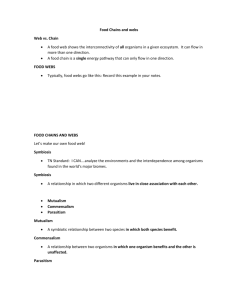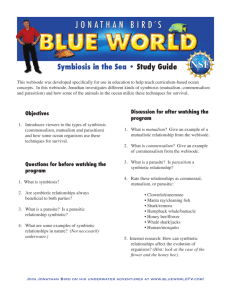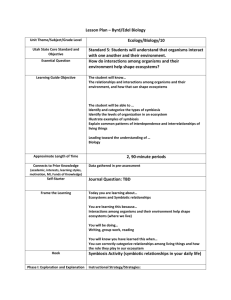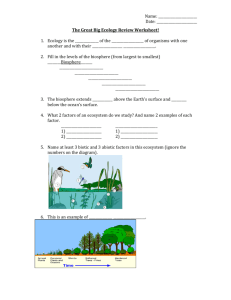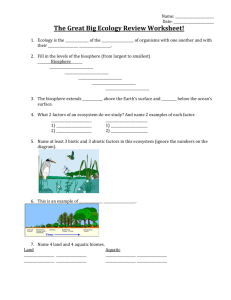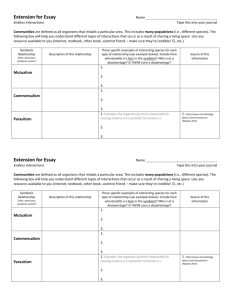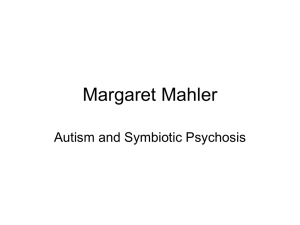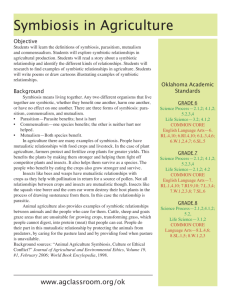Living in Sym: An Introduction to Symbiotic Relationships
advertisement
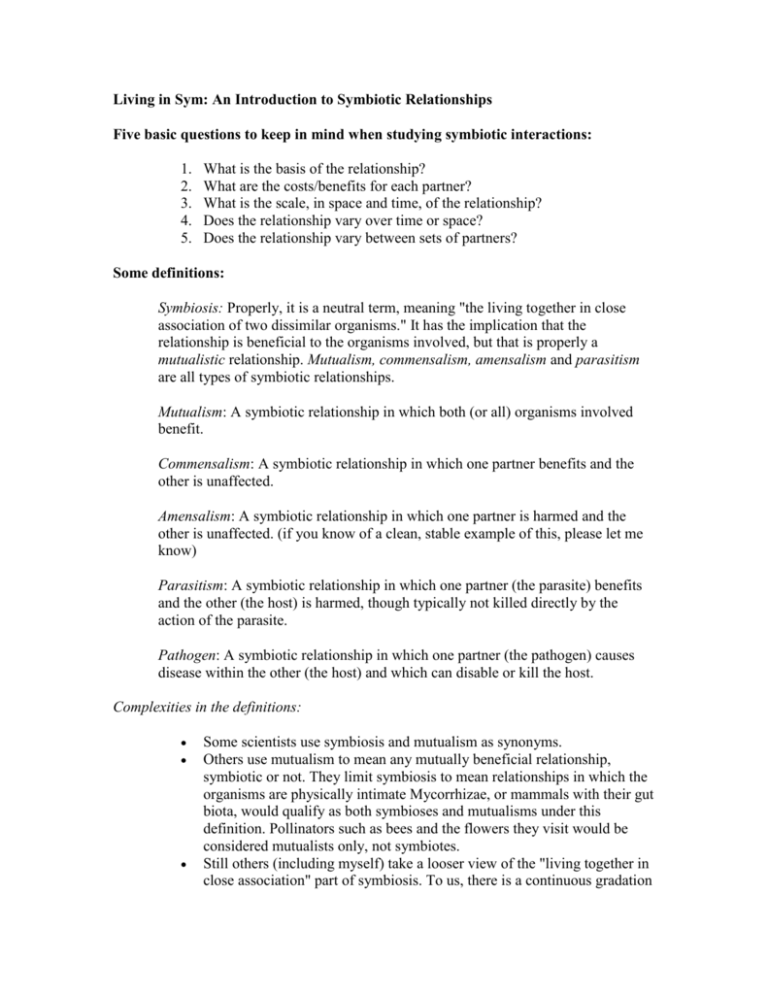
Living in Sym: An Introduction to Symbiotic Relationships Five basic questions to keep in mind when studying symbiotic interactions: 1. 2. 3. 4. 5. What is the basis of the relationship? What are the costs/benefits for each partner? What is the scale, in space and time, of the relationship? Does the relationship vary over time or space? Does the relationship vary between sets of partners? Some definitions: Symbiosis: Properly, it is a neutral term, meaning "the living together in close association of two dissimilar organisms." It has the implication that the relationship is beneficial to the organisms involved, but that is properly a mutualistic relationship. Mutualism, commensalism, amensalism and parasitism are all types of symbiotic relationships. Mutualism: A symbiotic relationship in which both (or all) organisms involved benefit. Commensalism: A symbiotic relationship in which one partner benefits and the other is unaffected. Amensalism: A symbiotic relationship in which one partner is harmed and the other is unaffected. (if you know of a clean, stable example of this, please let me know) Parasitism: A symbiotic relationship in which one partner (the parasite) benefits and the other (the host) is harmed, though typically not killed directly by the action of the parasite. Pathogen: A symbiotic relationship in which one partner (the pathogen) causes disease within the other (the host) and which can disable or kill the host. Complexities in the definitions: Some scientists use symbiosis and mutualism as synonyms. Others use mutualism to mean any mutually beneficial relationship, symbiotic or not. They limit symbiosis to mean relationships in which the organisms are physically intimate Mycorrhizae, or mammals with their gut biota, would qualify as both symbioses and mutualisms under this definition. Pollinators such as bees and the flowers they visit would be considered mutualists only, not symbiotes. Still others (including myself) take a looser view of the "living together in close association" part of symbiosis. To us, there is a continuous gradation between physically intimate symbiotes and ones that live separately, but which are necessary to each others' continued existence, and all of these relationships can be considered symbioses. In this view, pollination is a type of symbiosis. Interestingly, domesticated plants and animals are human symbiotes under this definition. The basic point to understand is that different people may mean different things when they use these words. More sophisticated scientists will try to define what they mean by each term when they use it. Others will not. It is a good idea to be aware of the possible misunderstandings that can arise from these definitions, and to be adaptable when reading the literature and listening to others. The Real World The problem with such nice definitions is that unwary people can get trapped into thinking of these terms as discrete categories. Mutualisms are always beneficial, parasitisms are bad, and amensalisms make no sense (after all, if neither partner is benefiting, why do it?). Furthermore, organisms do not switch from one category to another, except under special circumstances. In the real world, relationships are much more complicated. As humans, we know this from our own relationships, be they with pets, friends or spouses. Even though all of these relationships are (or should be) mutually beneficial, they usually are not at all times. Anyone who has ever been in an argument knows this, as does anyone who has helped a friend through a crisis. Dogs can bite as well as lick, and while they are wonderful companions, they also need to be taken for walks. The same is true for symbioses. For instance, mycorrhizae can take up to one quarter of a plant's photosynthate, and if they do not provide adequate nutrients in return, they are acting as functional parasites at that point. Bees may steal nectar from flowers without pollinating them. The key here is the scale and form of analysis, which is the point of the five questions at the top of this page. Relationships, symbiotic or not, tend to be dynamic, and the nature of the relationship depends on how it is being analyzed and the spatial and temporal scales of analysis. A good mycorrhizal example of this is a series of studies of English bluebells (Hyacinthoides non-scripta). These AM plants, which have coarse roots that are shed and regrown yearly, were the first species for which it was demonstrated that mycorrhizal infection was necessary for the plants to have a positive phosphorus balance in the wild. This was not simple, as net P flow cycled from positive to negative through the respective growing cycles of plant and fungus. Only by recording the P flows throughout the year, with and without mycorrhizae, did the researchers determine that AM plants had a positive P balance over the course of a year, whereas nonmycorrhizal plants did not (see summary in Smith and Read 1997). Most studies do not last as long or take so much care, and no one knows how many of them have problems with inadequate sampling. There is also the problem of units of analysis. In most mycorrhizal relationships, the fungal partner gives nutrients and takes in energy (as carbohydrates), whereas the plant takes in nutrients and gives energy. Converting from one unit to the other, in order to perform a cost-benefit analysis, is not simple, and scientists have had to come up with ways to handle the conversion. Even units of analysis have their shortcomings. Pets are an excellent example of this. By any energetic standard, most dogs are parasites. We feed them and take care of them, but (for the most part) they do not provide any care or feeding in return. Energetically and nutritionally, the flow is all one way--dogs, in this analysis, are parasites. However, if a dog stops an intruder from killing a human, then the dog might have enormous value. This provisional value can be calculated, although it is more difficult. But how does one quantify the value of companionship? Dogs help people live happier, possibly longer, lives, simply by being companions. Quantifying this benefit is extremely difficult, but it may be the most important one that dogs provide, one that makes them mutualists to humans, not parasites. Mycorrhizae have similar issues, most of which are probably unknown. Here is an example: For the fungus, a plant root is a habitat, a substrate in which it can grow. Compared to the soil, plant roots can be very safe environments, and the fungus may derive considerable benefit simply by stowing part of its mycelium in the plant, away from mycovores in the soil. As with the dog example, quantifying this benefit is difficult.The problem here is that the benefits dogs and plant roots supply may be counted as fitness, in the evolutionary sense. They may increase offspring, survival, etc., but not in a way that is easily measured or quantified without long and complicated studies. This is why symbiotic relationships should not be understood simplistically. The way one analyzes a relationship in large part determines what one sees. Short-term parasitic relationships may be mutualistic in the long run, and vice-versa. Moreover, a relationship may swing from beneficial to harmful over time. In this context, terms such as amensal make sense. They are stages which organisms pass through, rather than stable, longlasting relationships. Awareness of these potential complexities is critical. Given the complexity of working with roots and semi-microscopic fungi in a soil environment, it is obvious that we are only beginning to understand mycorrhizal relationships. They are fun though. From http://botit.botany.wisc.edu/courses/mpp/LivinginSym.html
